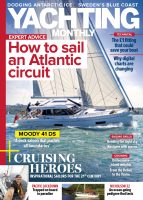In their entry to Yachting Monthly's Spirit of Adventure Award sponsored by Zhik, Kirstin Jones and Gary Hancock are thrilled by the untamed grandeur of South Georgia
Sullen clouds pressed down upon a pewter sea. To port, the mountains vanished into swirling mist; to starboard, Bird Island jutted from the restless ocean. I stood in the cockpit of Wandering Albatross, our 43-foot steel cutter, staring at the daunting passage in between – this was Bird Sound, our gateway to the remote southwest coast of South Georgia.
Gary steered us into the channel while I scanned ahead in search of the numerous dangers. Hornaday Rock, awash in the middle of the sound, was of particular concern. Sudden flurries of snow stung my face and my eyes streamed in the biting wind. Although we knew the deepest water lay close to Bird Island, my stomach churned as we navigated within a few boat lengths of the rocky shore.
‘There it is,’ I said, relieved to spot Hornaday Rock in the poor visibility. ‘About 10 o’ clock,’ I pointed. White water foamed around fangs of black rock less than a cable off, and Gary altered course by a few degrees. At that moment, a magnificent bird came gliding past the transom: our namesake, the endangered wandering albatross. We watched in delight as it soared in effortless arcs above the waves.

Wandering Albatross in Grytviken Dock, South Georgia. Photo: Kirstin Jones
Magical wilderness
To spend time with these remarkable birds was one of several goals that inspired our voyage to this isolated sub-Antarctic island. For over a month, we had been exploring the spectacular northern coastline.
We had been chased from anchorages by sudden wind shifts, weathered a ferocious storm and shovelled snow from the deck after a blizzard, but we had been rewarded with unforgettable encounters: hours spent watching the wanderers perform their elegant mating dances, a treasured glimpse of a southern right whale, and a beach shared with thousands of king penguins. It had been wild, magical, raw and exhilarating.
Just to be in this extraordinary place, where wildlife dominates, the weather can change in an instant and ice is ever present, was a constant challenge. But the even less accessible southwest coast was calling us. In a world where little remains to be discovered, sailing to this seldom-visited area promised true adventure, an opportunity to push our own limits and the chance to glimpse something of what the early explorers experienced when reaching new shores.

Walls of ice inspire both fascination and trepidation. Photo: Kirstin Jones
We monitored the weather closely, downloading new GRIB files twice a day. When the regular train of depressions affecting the island looked set to track north for a short period, we were ready: it was now or never.
Now or never
Leaving the anxiety of Bird Sound behind, we eased the main, killed the engine, and set the jib for a comfortable reach. Icebergs the size of houses loomed in the mist, driven aground by gales, sculpted into fantastical shapes by wind and sea. The swell surged and crashed around them. Gary and I were awed; we could almost believe we were the first people to set eyes on this inhospitable scene.
The clouds seemed to brush the mast top as we approached Undine Harbour. Relying heavily on radar, we picked our way into the bay amid beds of tangled kelp and dropped the anchor near the beach. An eerie wailing filled the air, like a thousand mournful voices crying for mercy.
Article continues below…
Hunted almost to extinction in the 20th century, South Georgia’s fur seal population had recently made a remarkable comeback and now numbers in the millions. The shore seethed with seals: hundreds of black pups and their protective mothers sprawled on the shingle, while posturing males guarded their harems.
Acutely aware that the spell of settled weather wouldn’t last long, we set off early the next morning towards King Haakon Bay, a deep fjord that pokes like a finger into South Georgia’s rugged interior. In a light westerly breeze, we set full sail and Wandering Albatross surged through the ruffled water.

Sailing along the north coast. Photo: Kirstin Jones
With no detailed charts available, we were dependent on the sparse information provided by the Admiralty pilot. Warnings such as ‘approach with great caution’ and ‘uncharted rocks exist’ didn’t inspire much confidence; we kept a sharp lookout.
Retracing Shackleton
One of our greatest ambitions was to land at Cape Rosa, at the entrance to King Haakon bay, where Ernest Shackleton and five of his men made landfall after navigating for 16 days through icy seas and hurricane-force winds. From Elephant Island, 800 miles away, they had set out in a tiny open boat, the James Caird, to seek help for 22 crew members left behind.
The expedition had been stranded for months in Antarctica when their vessel, Endurance, was crushed in pack ice in the Weddell Sea. Shackleton’s heroic effort to rescue his men, chronicled in his book South, remains one of the most well-known and epic maritime quests ever completed.
By the time Gary and I arrived at the cape, shafts of sunlight were probing through the clouds and the sea was a brilliant turquoise. With no possibility of anchoring, Gary stayed with Wandering Albatross while I rowed towards the entrance of the cove, no more than a slit in the rocks, and crept through to reach the boulder beach beyond. Timing my approach carefully, I rode in on a wave, sprang ashore and hauled the dinghy clear of the sucking sea.

Icebergs are a majestic but forbidding feature of the seascape. Photo: Kirstin Jones
I gazed around the little cove in wonder. Shackleton’s presence was strong as I tried to imagine the men’s exhausted euphoria at the moment they landed and heard the sound of the trickling fresh water stream nearby. I sat in the little cave, a shallow scrape in the rock face, where the men lived for days as they regained their strength.
I could picture them huddled there: Shackleton, Worsley, Crean, Vincent, McCarthy and McNeish, as they prepared a hot meal and planned the next stage of their race for survival. To be there, in their shadow, was a humbling experience.
While Gary repeated my journey into the cove, I motored Wandering Albatross in slow circles half a mile offshore, alone with my thoughts. Later, we sailed to the head of King Haakon bay, passing glacier after glacier. The rivers of jumbled ice glinted blue in the sunshine. The chart showed two insignificant specks: the Vincent Islands, behind which the pilot book suggested ‘anchorage may be found’.
In fact, the rocky islets provided unexpected shelter. Chunks of glacial ice fizzed and popped around the boat, releasing bubbles of ancient air as they melted. Gary fished out a fragment with the bucket and we sat outside in the cockpit to toast Shackleton and his men with a splash of single malt. Golden light washed distant, snow-capped peaks; it had been an exceptional day.

Sheltering in Trollhul, four miles northwest of Cape Disappointment at the mouth of Graae Glacier, along the south coast. Photo: Kirstin Jones
Closing weather gap
It was my turn to get up early the next morning, light the diesel heater and check the weather forecast while the kettle boiled. With a reasonable outlook, we decided to remain at anchor and explore ashore. From the stony beach, Wandering Albatross seemed dwarfed by the landscape. Steep cliffs rose into immense mountains behind her; ice fields shone high above. The isolation was striking.
We walked to Peggotty Camp, from where, against enormous odds, Shackleton, Worsley and Crean crossed the island, in winter, to seek assistance from the whaling station at Stromness. Shackleton then went on to rescue the rest of his team from Elephant Island. Remarkably, not a single man perished.

Gary on deck in a blizzard. Photo: Kirstin Jones
We departed from the fjord the next day, constantly trimming the sails in a fickle breeze. Perilous rocks guarded the entrance to Holmestrand, an inlet near the snout of the Esmark glacier, and a mass of drifting ice blocked our approach. From the bow, Gary pointed out the best route, and I steered through the maze of bumping ‘bergy bits’. All night the glacier groaned and thundered as it calved great ice chunks into the sea.
I was still snuggled into our cosy bunk when Gary presented me with a cup of tea the next morning and said, ‘I’ve got some bad news.’
‘What?’ I sat up. ‘It looks as if our weather gap is about to close. We’ll have to get moving.’ An intense depression with wind speeds in excess of 50 knots was developing to the west of South Georgia.
With no safe anchorages on this side of the island we would need to take shelter in Larsen Harbour, about 70 miles away, and we had less than 36 hours to get there. We pushed our way out through the jostling ice and headed for Trollhul, a slight indentation where we hoped we could stop for the night.
The sea was glassy and a gentle swell rolled in from the south. A stream of tabular icebergs, one measuring a mile long on the radar, filled our view to seaward. Penguins porpoised ahead of the boat and storm petrels pattered across the sea’s surface.

Gary sheets in the jib with South Georgia in the background. Photo: Kirstin Jones
Trollhul offered better shelter than we had anticipated; we dropped the anchor in front of a dazzling glacier. Aristocratic king penguins lined the shore, and on the gravel, huge elephant seals lounged side by side. The twin peaks of Cape Disappointment glowed in the evening light: this was the South Georgia of our dreams.
Emergency action
Gary and I started awake at the same instant. It was 0400 and just getting light. Wandering Albatross pitched and rolled in a building sea. We leapt out of bed, pulled our padded flotation suits over our thermals, and clambered outside. The wind sang in the rigging; waves hissed on the beach. The wind had picked up from the south and put us on a lee shore. There was no time to waste. Adrenaline surged as I brought up the anchor and Gary manoeuvred the boat out past the rocks and bergs.
Once clear of the dangers, we hoisted some sail and watched an orange dawn flood the sky. Wandering Albatross sliced through a boisterous sea and showers of spray sparkled in the crisp air. Cape Disappointment towered above. Captain Cook named this point when he rounded it in 1775 and realised that South Georgia was an island, not the fabled Terra Australis Incognito that he so longed to discover.
As Gary and I passed this southernmost tip of the island, we were seized by jubilation rather than disappointment. The wind backed to the northeast and on the final beat towards Larsen Harbour the barometer started to plummet.
Ominous clouds rolled in from the west. The window had slammed shut on a rare opportunity to sail the wild side of South Georgia, but the memories would remain forever.
This article is a part of our Zhik Spirit of Adventure Awards.
Enjoyed reading this?
A subscription to Yachting Monthly magazine costs around 40% less than the cover price, so you can save money compared to buying single issues.
Print and digital editions are available through Magazines Direct – where you can also find the latest deals.
YM is packed with information to help you get the most from your time on the water.
-
-
- Take your seamanship to the next level with tips, advice and skills from our experts
- Impartial in-depth reviews of the latest yachts and equipment
- Cruising guides to help you reach those dream destinations
-
Follow us on Facebook, Twitter and Instagram.





